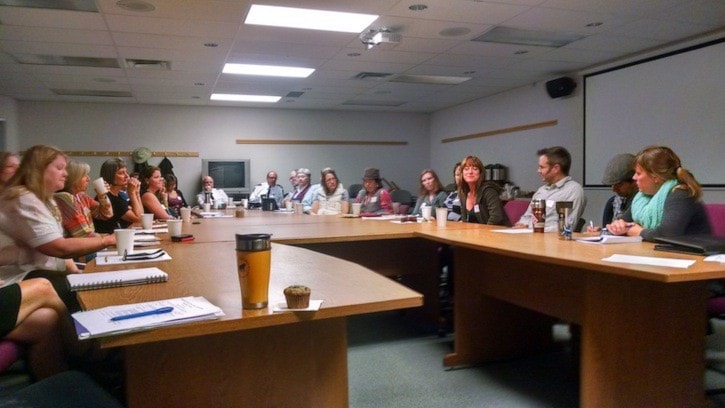It now has a name. It’s called the Nelson Street Culture Collaborative. It has met, nameless, twice before in the past six months.
The purpose of the group is “to create a community-wide strategy for how to respond to those who rely on street culture to survive,” according to its initiator and main driving force, Rona Park of Nelson Community Services.
The street culture collaborative’s third meeting on Oct. 1 was attended by representatives from about 25 organizations (see list below).
Park says the street population often comes in contact in one way or another with any or all the agencies on that list, but each organization doesn’t know what the other is doing and each sees the street population through different lenses.
She says the latest meeting had people around the table who don’t normally cross paths, and that is what’s needed.
Why so many people? Why more talk?
• Rona Park: “Because we all need to step up. We all have to broaden our understanding. Because community development and finding the right things to do, these things take time.”
• Mayor Deb Kozak: “Because the talk in the past has been in silos. For example, the police talk to the police board and maybe some part of the community, broadcasting their alarm, but have not had a chance to talk to this larger range of people like, for example, the Selkirk College nursing program people who were there.”
• Police chief Wayne Holland: “Because of the people who are on board so far. These people are doers as well as decision-makers. They are all subject matter experts. We are taking baby steps. I am very optimistic. I know some of these kinds of discussions can be a lot of hot air — that happens all over the world — but I don’t think this one will be.”
The group struck a subgroup to research how other communities, specifically big cities, bring such a large stakeholder group to bear on a social issue: how they work together, what they measure, how they communicate, and what they do.
Eight people are on the research subgroup representing the Interior Health Authority, business community, police, education and social services.
As for the larger group, Kozak says its members are getting to know each other.
“I want us to ask the hard questions and deal with them in front of everybody,” she told the Star. “Often people will mutter behind the scenes. It takes courage to deal with those questions in a supportive group situation and that is what I want and where real change will happen.”
Asked if one of those hard issues was the common sentiment that street people should buck up and get a job, or that social service agencies conspire to invite more street people to town so they can get more funding, Kozak agreed those were good examples, but those questions haven’t surfaced around the table yet.
In starting and guiding the collaborative, Park is relying on a proven method known as a collective impact initiative (see below). She says the group is currently working on the first two stages: developing a common agenda and shared measurements.
Organizations involved in the Street Culture Collaborative
*Those followed by an asterisk were invited but did not attend
Public safety sector
• Nelson Police Department
• Victim Services
• RCMP*
• Restorative Justice
Community services sector
• Nelson Community Services Centre — homeless outreach programs
• Nelson CARES Society — Transitional support program
• ANKORS outreach programs
• Nelson Committee on Homelessness
Faith sector
• Our Daily Bread daily hot meal program
• Salvation Army daily drop-in breakfast program
• Nelson United Church*
Health and mental health sector
• Interior Health Authority
• Kootenay Division of Family Practice*
• BC Ambulance Service*
• Forensic Psychiatric Services
Business sector
• Chamber of Commerce
• Nelson Business Association
• Downtown business owner
City and public services sector
• Nelson Public Library
• Nelson Youth Centre*
• City council and public works
Education sector
• School District 8
• Selkirk College Nursing
• Selkirk College Social Work*
The basics of collective impact initiatives
1. A Common Agenda — all participants share a vision for change that includes a common understanding of the problem and a joint approach to solving it through agreed-upon actions.
2. Shared Measurements — all participants agree on the ways success will be measured and reported, with a short list of common indicators identified and used for learning and improvement.
3. Mutually Reinforcing Activities — a diverse set of stakeholders, typically across sectors, coordinate a set of activities through a mutually reinforcing plan of action.
4. Continuous communication — all players engage in frequent and structured open communication to build trust, assure mutual objectives, and create common motivation.
5. Backbone support — an independent, funded staff dedicated to supporting the initiative’s activities.
